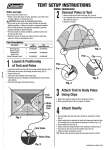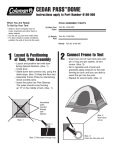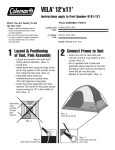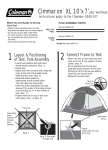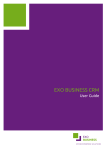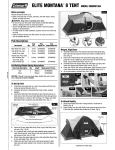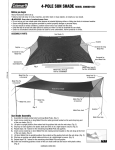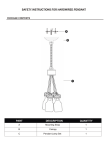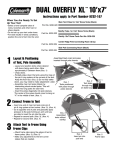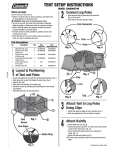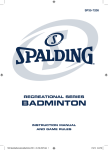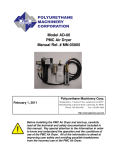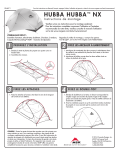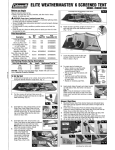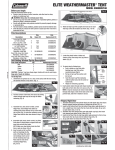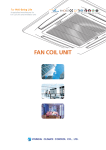Download Mantra 6 - Greg Zulkie
Transcript
Kelty USA Mantra 6 Redesign Analysis and Proposal Mantra 6 proposal done by Greg Zulkie at Carnegie Mellon University, December 2006. Proposal for Kelty USA, by Greg Zulkie Kelty is a brand built on low-cost innovation. The current product line is dependable and admirable, but another look at manufacturing and use of materials will make Kelty’s products once again stand out as a leader in outdoor gear for serious adventurers. The Mantra 6 is a large tent that will most likely be used by a family that is experienced with camping, but not serious about gram-shaving and sparse living. They will most likely have a car to get their equipment where it is needed. Product Breakdown: Each numbered item represents a different part of the product and as a result, each is an element in the overall experience. Greg Zulkie • December 2006 Kelty USA Mantra 6 1. Rainfly 2. Exterior Vents & Guylines 1 3. Interior Vents & Screens 4. Aluminum Poles 5. Floor & Waterproofing 6. Interior Walls 2 7. Pole Sleeves 3 7 4 5 6 Greg Zulkie • December 2006 1 Kelty USA Mantra 6 Rainfly OVERVIEW The rainfly of a tent is one of the most important functional elements that a tent has. With a low quality rainfly, campers will awake to a most unpleasant wet experience. Water resistance is of upmost importance. The current fabric in the rainfly is a high-density 1800mm nylon taffeta. It is coated in a urethane seal for waterproofness. ASSOCIATIONS The rainfly is a bulky object that can be confusing to put on the tent. It doesn’t have a smell when new, but as it ages, especially if it is packed wet, mildew will form and it will take on a musty odor. The rainfly is also slightly stretchy and when tied down properly, the tension in the tent makes it feel solid and safe. The fabric is still and noisy, but this adds to the sturdiness. The seams of the nylon are specially taped (sealed) as an extra measure of water resistance as well as an increased look of quality. It is a feature that can be advertised to the consumer to inform them of the quality of the material/product. AGING Over its life, the nylon will lose it’s water resistance. It will also grow mold and fungus. If not treated properly, it is susceptible to punctures and to a lesser extent to rips and tears. If the consumer is dedicated enough, he or she can buy products that will reseal the rainfly from water. Proposed Material Changes: 1 What: Flexible photo-voltaic solar panels. Why? Tents, once set up, sit out in the open, often in direct sunlight. How It Works: It is no secret that when a tent sits in the sun all day it gets very hot. It only makes sense to make use of that energy hitting the tent’s rainfly all day. With a surface area as large as the Mantra 6, copious amounts of solar energy could be put to good use. When the panel comes into contact with light, photons in the sunlight are absorbed by semi-conducting materials, such as silicon. Electrons are knocked loose from the silicon atoms. This allows the electrons to flow through the material and produce electricity. This system creates DC electricity. Alternatively, the power can be put through an inverter make AC power. Applications: Solar cells could be very useful for the casual and family camper. The user could charge cell phones in case of emergencies, powering lights and cooking appliances are also a good use of power. Free power in the campsite would also benefit those who want access to the luxury of iPods and other devices that will lose battery power quickly. bringing home to the campsite Greg Zulkie • December 2006 Greg Zulkie • December 2006 2 Kelty USA Mantra 6 Exterior Vents & Guylines OVERVIEW In the Mantra 6, the secondary colors in the rainfly represent the vents and tie-down areas. This areas are made of the same nylon as the gray parts of the rainfly. ASSOCIATIONS The Mantra 6 features a rainfly that completely covers the tent. This is good for weather protection, however it is impedes ventilation during hot nights. The guylines are a simple nylon weave and when combined with the plastic tightening devices, they are the cheapest feeling aspect of the tent. The tie downs that run along the bottom of the rainfly also don’t appear to do much for the structure of the tent, but in reality it holds the rainfly away from the inner tent walls. The upper guylines are not necessary in every situation, but become important in high winds and make the tent essentially rock solid. The guylines are held in place by aluminum stakes, which are very lightweight, but in practicality, aluminum does not give the user confidence in its strength, as they often bend on rocks or hard packed dirt when pushed or hammered in the ground. AGING The guylines are fairly thin and are not a high-count or smooth weave. This would suggest they are more prone to fraying. They are also black and are very easy to trip over, day or night, which causes damage to the rainfly or stakes. Proposed Material Changes: 2a 0.125” What: Spectra cord for guylines. Why? The current nylon cord used with the Mantra 6 feels cheap and does not give the user much faith in its strength. Spectra, as a material, is trusted in the rock climbing world as one of the 0.04” strongest pieces of safety equipment. Kelty already has this product available in house! This cord has a diameter of 0.0875” and a breaking strength of 188lbs, more than enough to help a tent withstand the highest of wind speeds. Higher-end versions of this cord can be manufactured up to a breaking strength of 1109 lbs. @ .125” diameter or a minimum diameter of 0.04”. Applications: When used for cord, Spectra weaves would be much stronger than regular nylon as well as drastically improve the quality and feel of the guylines. The reflective material already included in Kelty spectra cord will help people from tripping on the guylines at night. bringing home to the campsite Greg Zulkie • December 2006 Greg Zulkie • December 2006 Kelty USA Mantra 6 2b What: Nickel Titanium Tent Stakes Why? Normal aluminum tent stakes have two major flaws. First, their round How It Works: shape makes them easy to pull out of the ground when it is wet or when someone trips over a guyline. Second, when the stake is pounded into hard ground, or not hammered carefully, it will bend and become unusable. This is particularly bad when camping far away from a sporting goods store and not having extra stakes. Wouldn’t it be nice if the stakes could straighten themselves? It’s possible even in the wilderness, all you need is a staple of outdoor living: a campfire. Nickel Titanium is a “shape memory alloy;” it remembers it’s original geometry even when bent out of shape. The shape of the stake is set by heat and by varying the properties of themetal, can be told at what temperature to “remember” its shape if deformed. For a campsite a good trigger temperature would be about 400˚F. Applications: Obviously this is a perfect material to be used in tent stakes, not only for its memory, but also it’s strength and light weight. In addition, using an extrusion process, stakes could be manufactured with a screw-like twist that would make them harder to pull out of the ground accidentally. 400˚ Proposed Material Changes: 2c What: Higher quality guyline tensioners. Why? The current tensioners included with the Mantra 6 have the same low quality feel of the guylines. These bits of plastic actually dig into the nylon, wearing it out over time. Larger and made with better plastic, the tensioners would continue to promote the level of quality the Mantra 6 has. A hard, heavy plastic like polycarbonate with a doube-shot layer of a thermoplastic elastomer would produce this level of quality. Applications: This kind of attention to detail is what the current customer demands in all markets. Similar to the way a knob turns or door closes in an automobile, the feel of tensioning the guylines on the Mantra 6 should be a pleasurable experience that rewards the user with the feeling that they own the highest quality tent on the market. bringing home to the campsite Greg Zulkie • December 2006 Greg Zulkie • December 2006 3 Kelty USA Mantra 6 Interior Vents & Screens OVERVIEW The Mantra 6 is a 3-season tent. This means that it has much more ventilation than a tent that is used for winter camping or on Everest. Though it is a 6-person tent, space is small when six people are actually occupying the tent. If the tent was solid nylon fabric, it would get very stuffy very fast. ASSOCIATIONS The fabric that makes up the mesh is much softer than the tent walls. It is a much finer weave than the screens found on doors in houses. When looked at from the inside, the mesh contrasts the light nylon with a darker mesh that wraps around the occupants and makes the tent feel safer. This mesh is superior to normal screens because the finer weave will keep out the tiny biting flies called “noseums.” It is also less likely to catch on rough objects rubbed against it, because it is so fine. The mesh is used liberally in the Mantra 6 in order to adequately ventilate the tent. AGING Over the life of the tent, the fine mesh will see some wear and tear, since it is easy to rub against while moving about the tent. It shouldn’t break down if the tent is taken care of correctly. If it is ripped, however, it will not be able to be repaired in a way that will look the way it used to and will probably not keep the bugs out in that area. In the case of a knife puncture, it is very likely the tear will run along the entire screen. Proposed Material Changes: 3 What: Carbon fiber-weave mesh. Why? Carbon fiber is a modern thread-like material that is extremely How It Works: strong. Used in many applications, it has become a staple material of high-quality products. It’s high-tensile strength will improve the mesh in the tent. Carbon fiber thread is created through oxidation of the polymer polyacrylonitrile (PAN). When heated, the molecules bond to form long round chains and results in a carbon purity of 93-95%. Carbon fiber thread can even be dyed instead of keeping its natural glossy finish. Applications: When applied as the mesh material to the Mantra 6, it will make the mesh a strong point in the tent’s wall structure, rather than a weak point. It will also make accidently tearing the screen virtually impossible. If a tear were to occur, carbon fiber would not tear down the entire screen like normal mesh fabric will. bringing home to the campsite Greg Zulkie • December 2006 Greg Zulkie • December 2006 4 Kelty USA Mantra 6 Aluminum Poles OVERVIEW There are two main materials used in tent poles: fiberglass and aluminum. Generally speaking, fiberglass is a flimsier and cheaper material. It is also more likely to break under stress and is heavier. Kelty aluminum poles are anodized in different colors to color-code assembly. ASSOCIATIONS The anodized surface of the poles is cool and shiny. Unlike its use in stakes, the aluminum’s weight and quality of surface is much better than that of fiberglass. However, it is still possible to permanently bend the poles out of shape if the user is not careful. They are also still moderately heavy for their strength. In a 6-person tent, the poles make up a large percentage of the tent’s weight. The Mantra 6 has 3 poles that factor into the tent’s weight of 18lbs 13oz. The most satisfying aspect of setting up a tent is using the bungee cords found inside the poles to automatically snap them together. However, according to the user manual, this is not recommended. The diameter of the poles plays a big role in how the user feels about the poles’ quality. The Mantra 6’s poles are thicker than the standard fiberglass poles, yet weigh the same. Therefore, the user is not penalized in weight for poles that not only look and feel stronger, but are in fact stronger. AGING The aluminum poles will have a long life if taken care of. They won’t rust as long as the anodized finish remains on them. The weakest link on the poles is the bungee cord that holds them together. They are likely to break after enough use under regular conditions. Proposed Material Changes: 4 What: ExoGrid Triangulated Composite Frame. Why? The tent poles make up a large amount of the tent’s weight. Vyatek’s How It Works: proprietary process already has been applied to bicycle frames and certain automotive applications. Using it in tent poles will lighten them and allow the use of multiple materials to maximize strength and flexibility. It starts with a base metal, such as aluminium or titanium. These tubes are laser machined and a diamond pattern is removed, drastically lightening the material. A second material is inserted inside and is fused using Vyatek’s patented process. Applications: There are several possibilities with this process. The first is using the standard Exogrid materials: titanium casing with a carbon fiber insert. Not only will this lighten the poles significantly, but they will also look like mini structural elements from a building, adding to the overall feeling of security a well made tent should give the users. The second option would be to use Nickel Titanium, allowing the each pole to be one solid tube, eliminating shock cords. The poles could be coiled and would return to their shape upon being released from the bag. bringing home to the campsite Greg Zulkie • December 2006 Greg Zulkie • December 2006 5 Kelty USA Mantra 6 Floor & Waterproofing OVERVIEW Second only to the rainfly, the floor of the tent is the next defense against water entering the tent. Unlike the rainfly however, the floor of the tent can be subjected to prolonged standing water. Though it is coated with urethane like the rainfly, it will seep water if it is sitting in a puddle. Though it is obvious to the experienced camper to not set up a tent on low ground, beginners often find themselves in this situation and a wet sleeping bag is uncomfortable and potentially dangerous in cold weather. As a result, a second layer of cover is used under the tent. In the case of the Mantra 6, it is generally good to use the customized ground tarp, available separately from the tent. ASSOCIATIONS The floor is a material that is touched by everyone who enter the tent, but truthfully, it is the terrain underneath that is translated to the people inside. Picking a rocky campsite will make for an uncomfortable tent, a grassy campsite will aid in cushioning the user. The floor of the tent is also where the inevitable dirt collects. The corners of tents are notoriously hard to clean. The floor of a tent is a place that the user will probably try to avoid touching, unless they clean it thoroughly. Proposed Material Changes: 5a What: Conductive Polymer Why? If coupled with the solar panel on the rainfly, a conductive polymer How It Works: will act as an organic battery, storing up energy for use at night. As an added benefit, conductive polymers can be used as mild heating elements. These polymers are known as organic semi-conductors and are made out of carbon-based materials. As the material is cooled, the carbon materials form circuits that electricity can be passed through. As it is warmed, the circuits are broken. The temperature at which this occurs can be controlled. Applications: Using a conductive polymer as an organic battery makes sense for camping, because it would allow the user to not have to worry about setting up a system in conjunction with the solar panels. Instead, the user would only have to plug their devices into a DC outlet built into the tent. Using transformers, this Outlet’s voltage could be changed for different devices. The second application is to double the use of the conductive polymer as a heated floor. If the temperature were to drop to 35˚, the floor could begin to slowly heat, drastically improving comfort as the temperature drops below freezing. micro carbon contacts bringing home to the campsite Greg Zulkie • December 2006 Greg Zulkie • December 2006 Kelty USA Mantra 6 5b What: Ultrasonic Fabric Welding Why? This Process is just beginning to make its way into the outdoor How It Works: high-adventure market. It has been used for years in both the metal and plastic industries and will drastically improve waterproofness. A Sonic welding machine takes the pieces of fabric that need to be joined and vibrates the edges against each other at 20-50khz, this causes the molecules in each piece to mesh, creating an unbreakable, stitch-less bond. Applications: normal sewing temporarily attaches nylon with third medium This process should replace seam stitching and taping entirely. Seams are the weak point in terms of waterproofness. Sonic welding removes this weak point and makes seams just as strong as the rest of the sonic welding mixes molecules from both pieces fabric. This process is also being adopted by other manufacturers and permanently bonds the nylon together. as a selling point, however it has yet to be applied to tents. It would be extremely advantageous brand-wise to be the first to use this innovation. Proposed Material Changes: 6 Interior Walls OVERVIEW The interior walls of a tent give it the coziness that many enjoy about tent camping. Interior walls are thinner than the rainfly and only lightly waterproofed. If it is raining and the rainfly is touching the interior walls, water can transmit through both fabrics into the tent. The Mantra 6’s rainfly has to keep the interior dry. Again, since the Mantra 6 is a 3-season tent, its thin walls and accompanying mesh do not insulate very well. In fact, it is more likely that the vents remove heat from the tent. ASSOCIATIONS The Mantra 6’s walls are a lighter gray than the rainfly and transmit light into the interior like a softbox in a photo shooting studio. This bathes the tent in a cool, relaxing light during the day and does not absorb the light from flashlights at night. This nylon has a musical quality to it. When one runs a finger across it, the fabric sings a high pitch and feels smooth. Between the gray color and thinness, it gives the interior space an airy feel. AGING The water proofing on the bottom of the tent will be the first to go if there is no tarp underneath. It is also the most likely to be damaged from wear and tear and discolor from dirt. bringing home to the campsite Greg Zulkie • December 2006 Greg Zulkie • December 2006 6 Kelty USA Mantra 6 What: Drapilux Air: air freshening fabric Why? Over time, tents tend to develop a musty mildew smell, especially How It Works: if not dried and packed properly after each use. Six people living in one small space where showers aren’t a priority can add unpleasantness as well. This fabric uses materials that are not only flame retardant, but also use catalytic reactions with the air passing through to remove odors and pollutants from the air. It works the same was as a catalytic converter found in a car. Applications: If used as the main tent fabric, the air circulating through the tent will be even purer then the outside air. This will remove any odors inside the tent. Fire is also a danger when camping. Drapilux Air has a significantly higher resistance to fire then normal tent materials. Finally, this material has been proven to reduce airborne allergens from the air, making life for someone allergic to weeds and pollens not as miserable while camping. Proposed Material Changes: 7 Pole Sleeves OVERVIEW The final element that holds the Mantra 6 together is the pole sleeves. These are an improvement over clips because they more evenly distribute stress over the structure of the tent and can withstand much larger forces than a clip-only design. They also make set-up easier, the camper has only to simply slide the poles into the sleeves and secure one end of each pole. The other ends of the pole seat inside the sleeve. ASSOCIATIONS The sleeves are an example of adding another feeling of security from the structure of the tent. Though they add to the strength, the fabric that makes up the supports for the sleeves gets in the way of air movement through the rainfly and into the tent. Without a breeze coming in from outside, not too much air can get into the upper vents of the interior structure. AGING The sleeves are the mostly likely culprits of dye-bleed onto the tent walls. Other than that, however, they will likely last as long as any other sewn part in the tent. bringing home to the campsite Greg Zulkie • December 2006 Greg Zulkie • December 2006 7 Kelty USA Mantra 6 What: Lumalive LED fabric Why? In the wilderness, artificial light is at a premium for both easy of How It Works: movement and safety. By utilizing the solar power of the improved rainfly, the Mantra 6 could provide light for its occupants and make itself visible from a distance. The electric pathways and LEDs themselves are integrated into the fabric, making them indistinguishable when not turned on. They are also waterproof. Applications: There are two applications for Lumalive. This first is providing ambient illumination inside the tent. Unlike a camping lantern, which creates harsh shadows, the soft glow of LEDs all around the tent will be much more pleasing and comfortable. The user could even change the color of the light, white for normal use and red light if they did not want to reduce their night vision. The second advantage would be that the tent would not be damaged unintentionally by others in group camp sites or hunters in the dark. In fact, users trying to find their way back to their campsite in a group camp would have a very easy time of it. Greg Zulkie • December 2006





















